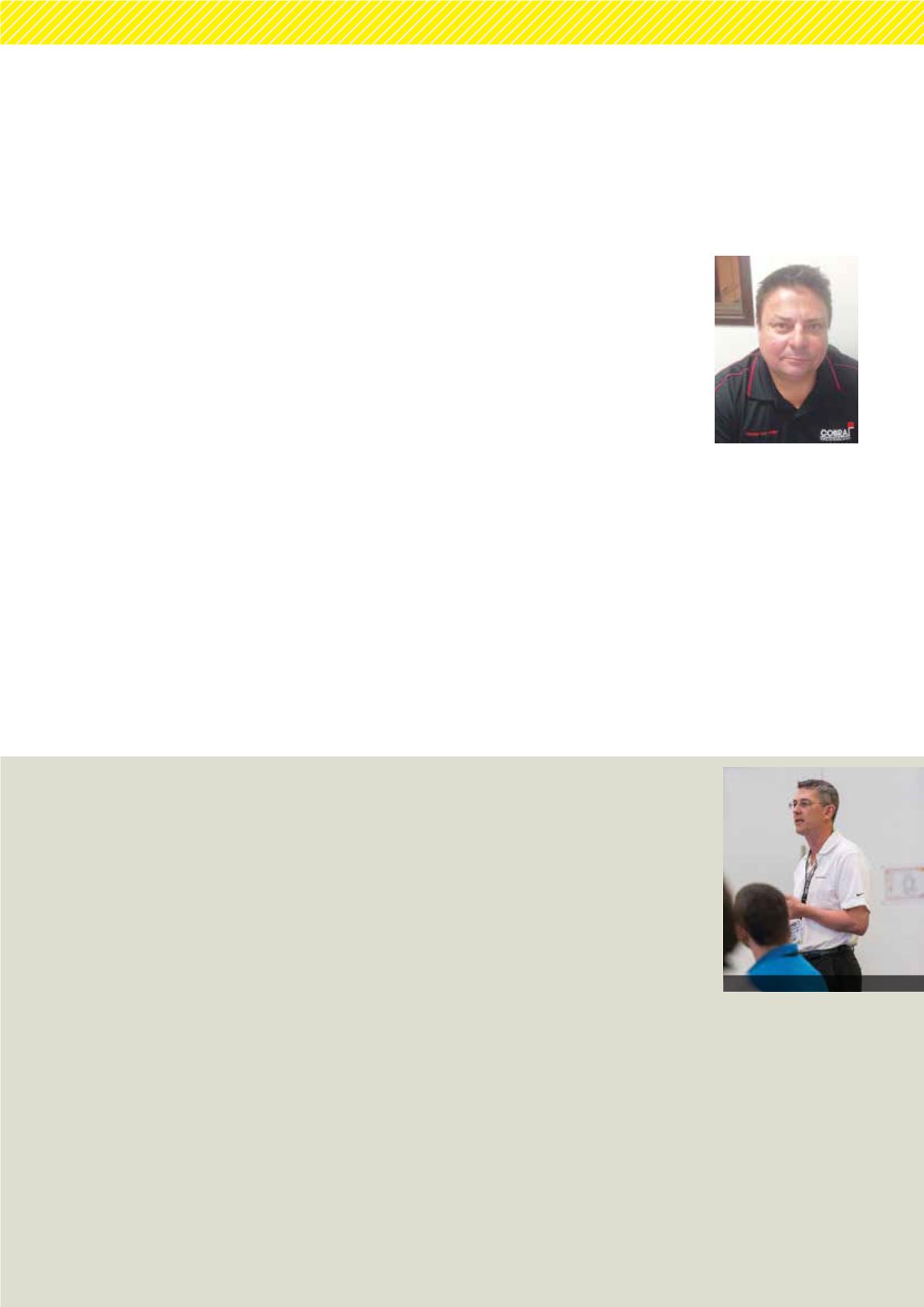

ACCESS in ACTION
Chris has a long history in the access
industry having worked in access hire
before recognising an opportunity in
the market to develop his own business
offering Yellow Card training.
For the TSHA, it is a win-win, having
an experienced industry training
professional stepping into the role.
“Cobra Training & Licencing Service has
been around for about 13-14 years now,
initially offering Yellow Card Training,
branching out to also offer telehandler
training around 2006-2007,” Chris said.
“I’ve been a member of the TSHA since
its inception and was on the founding
executive committee as the Training
Advisor for the association. I oversaw the
TSHA Gold Card training program and its
updates and improvements.
“We had the original Gold Card (TSHA
training) program we started with
but have now aligned it to a unit of
competency – RIIHAN309A. The Gold
Card has now been through two updates,
the D-Code and E-Code updates.
“We did a roll out to all trainers after
An introduction to the newTSHA President
The Telescopic Handler Association of Australia (TSHA) has a new President – Chris
Taylor, General Manager for Cobra Training & Licencing Service – a Registered Training
Organisation, who steps into the role after many years serving on the TSHA committee.
the initial alignment and spent about 12
months on the second upgrade. We are
now reshooting the training DVD, adding
scenes and revamping it,” he said.
Chris said TSHA training usually takes
between one-two days to complete
but that depends on the size of the
group, their previous experience with
telehandlers, and how many attachments
they’re learning.
“I am happy to step into the role of
President. Our committee is dedicated
and has been working hard on:
• Registered Inspector Program for
annual inspection testing
• Development of checklist for hire
companies and repairers
• Stability testing and compliance with
Australian Standards
• Compliance checklist for older
machines
• Standardisation of load chart
information is ongoing (different for
each manufacturer).
“The TSHA committee gives up their time
to undertake
these initiatives.
We meet four
times a year and
always need
volunteers to
help prepare
jobs.
“There have
been a lot of
accidents in
recent months which basically resulted
from people not understanding how
telehandlers work or what standards
operators have to meet.
“Members have voted to have our own
industry Standards for telehandlers. We
think this might be a world first. We have
members on the Australian Standards
committees to help that happen.
"So there are a lot of great things
happening for the TSHA now but we can
always use some assistance to help our
industry get better. Give us a call.”
Contact Chris on: 0448 450 132 or visit:
www.tsha.com.au
“There are some exciting things
going on standards wise in the North
American market. Both the Canadian
and US Standards are about to change
and become more in line with ISO and
European and Australian Standards as
well, which, from a manufacturing stand
point is a great thing," Brad said.
Brad said a global standard, from a
design, user and training perspective
would be great.
“Every country and manufacturer has
their own regional interests, methods,
regulations and infrastructure and they all
want to have control of their standards.
"But from a manufacturing perspective,
gravity is the same for everyone in the
world; ultimately it will still make you fall,
wherever you are. Job sites are job sites
International standards and regulations on EWPs
everywhere. When you put people to work
at height if it’s safe here, then it’s safe
there; and it should be safe everywhere.
“I think the most effective, efficient and
safe way to work at height is with the
machinery we have in our industry today.
If we let people who are not experts in
our machinery, not experts in our industry,
decide what is safe on our machinery,
we’ll get to a point where machinery will
be too expensive because we will have
had to design every type of safeguard and
fail safe into the equipment.
“Yes, we need to make people practically
safe. But I can’t see how we can get to
the place where every single event or
incident can be covered. That’s what this
space between your head is for, right?
“This is where the operator’s intelligence
comes into play.
We need to rely
on that. If rental
rates continue
to go down and
we continue to
regulate and have
greater requirements on the equipment
eventually people aren’t going to use the
equipment anymore and that will be a
step backwards in workplace safety.”
Brad also mentioned a new work item on
ISO TC 214 for control standardisation on
EWPs. He said it is a real possibility we
could be seeing common controls and
safety aspects on EWPs into the future.
“That will be a great step forward for our
industry.”
Visit: www.skyjack.com
At the EWPA Seminar at HIRE16, Brad Boehler, Skyjack President gave
a presentation on international standards and regulations and what we
can expect in the future. Here is a summary of what was said.
42
ACCESS IN ACTION • AUGUST 2016
Brad Boehler









